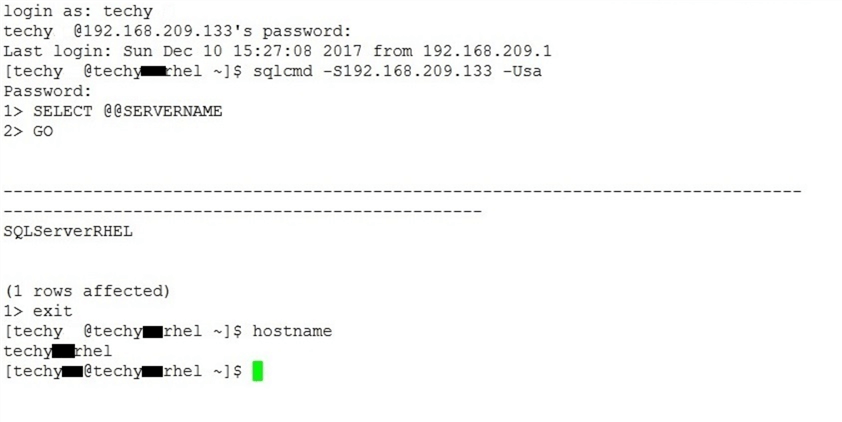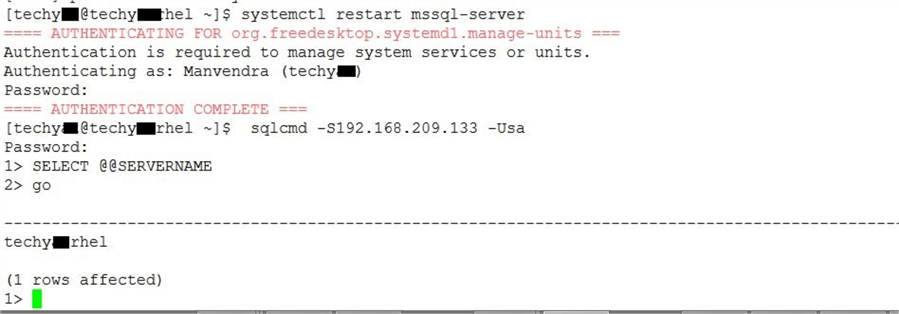By: Manvendra Singh | Comments (2) | Related: > SQL Server on Linux
Problem
Sometimes we need to rename a SQL Server instance name to make it conform to our naming conventions for our environment. If we change a Linux server name, then also we need to change the SQL Server instance name to avoid any issues. In this tip, we will cover how to rename a SQL Server instance running on Linux.
Solution
The process to change a SQL Server instance name has not changed from how it is done on a Windows based SQL Server. We need to drop the existing SQL Server instance name using system stored procedure sp_dropserver and then we need to add the new SQL Server instance name using system stored procedure sp_addserver.
I need to change the instance of SQL Server because I had already change the name of the Linux server where SQL Server is running. I will show you the step by step process in which I have described how to change a SQL Server instance name in the below sections.
You need to be careful when changing a SQL Server instance name to make sure it does not impact anything relying on the name.
NOTE: BE SURE TO TEST THIS SOLUTION IN A LOWER LIFE CYCLE FIRST. DO NOT MAKE CHANGES IN PRODUCTION WITHOUT PROPER TESTING IN LOWER LIFE CYCLE ENVIRNOMENTS.
Rename SQL Server Instance Running on a Linux Server
Step 1:
The first step is to check the name of the existing Linux server and SQL Server instance name. Launch the PuTTY console to establish a connection to the Linux server where SQL Server is installed. You can also directly log in to the Linux server and make a connection. I have used PuTTY to make the connection. Enter your login name and password to establish the connection. Once connected to the Linux server, we will connect to the SQL Server instance.
Connect to the SQL Server instance using the sqlcmd utility and enter the password once prompted.
sqlcmd -S192.168.209.133 -Usa
Check the SQL Server instance name once connected to SQL Server by running the below command.
SELECT @@SERVERNAME
Exit from the sqlcmd prompt to check the Linux server host name by typing the below code command.
hostname
You can see below the SQL Server instance name is SQLServerRHEL whereas the Linux host name is techyrhel.

Step 2:
Now we must change the SQL Server instance name to match the Linux server name. Again, connect to SQL Server instance using sqlcmd and run the below command to connect to SQL Server.
Pass your SQL Server instance IP and sa password while password prompt for sa account.
sqlcmd -S192.168.209.133 -Usa
Once connected to the SQL Server instance, we will drop the existing SQL Server instance name from the system metadata and then we will add the new name using system stored procedures. Once connected to SQL Server instance then you need to run the below commands to make these changes.
Drop the existing SQL Server instance name SQLServerRHEL by running the below command.
sp_dropserver SQLServerRHEL
Add new instance name of techyrhel to the system metadata by running the below command.
sp_addserver techyrhel, local
See the below image where we have executed the above commands successfully.

You can check the SQL Server instance post running the above commands, but this might show you the old name. We need to restart the SQL Server service to apply these changes to reflect the new name.
Step 3:
Here, we will restart the SQL Server service using the below command.
Restart SQL Server service.
Systemctl restart mssql-server
Once you will execute the above command it will ask you to enter your password. Enter your password to proceed with this operation. Once the SQL Server service restarts, you can check the SQL Server instance name again to validate the changes. Connect to the SQL Server instance on your Linux terminal using the sqlcmd utility.
Connect to SQL Server with sqlcmd.
sqlcmd -S192.168.209.133 -Usa
Enter the sa password, once connected again run the below command to check the SQL Server instance name.
Check the SQL Server instance name.
SELECT @@SERVERNAME
Once you execute the above commands you will get the new name of the SQL Server instance. You can see this in the below screenshot.

Now you have changed your SQL Server instance name running on a Linux server.
Next Steps
- If you are using older SQL Server instance name to make SQL Server database connections from applications, then you must change the connect string for that application as per the new name. Otherwise your application will face connections issues.
- Read more about SQL Server on Linux
- Read these other SQL Server Database Administration Tips.
About the author
 Manvendra Singh has over 5 years of experience with SQL Server and has focused on Database Mirroring, Replication, Log Shipping, etc.
Manvendra Singh has over 5 years of experience with SQL Server and has focused on Database Mirroring, Replication, Log Shipping, etc.This author pledges the content of this article is based on professional experience and not AI generated.
View all my tips






